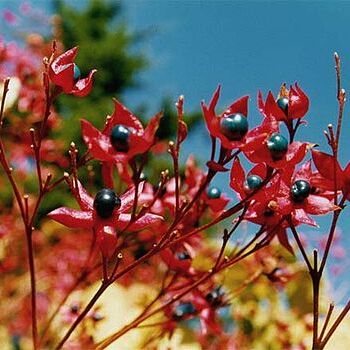Trees, shrubs or lianes or occasionally perennial herbs or pyrophytes with large woody rootstocks, sometimes with persistent spinescent petiole-bases often acting as scrambling aids. Leaves simple, opposite or in whorls of 3–4, entire or toothed. Flowers in lax cymes, extensive panicles or dense corymbs or heads, axillary or terminal, often appearing axillary but actually terminating abbreviated shoots, rarely solitary. Calyx often coloured and showy, campanulate to tubular, truncate to 5-toothed, often accrescent in fruit. Corolla white, blue, violet (etc.) or red, almost regular or quite irregular; tube narrowly cylindrical, straight or curved, often widened towards throat, sometimes very long or only as long as calyx; limb spreading or reflexed, the anterior lobes larger than the posterior pairs. Stamens 4–5, didynamous, inserted in the corolla-tube, alternate with the lobes, usually long-exserted. Ovary imperfectly 4-locular, each locule with one lateral ovule. Style terminal, elongate; stigma shortly 2-fid, exserted. Drupes obovoid or globose, often 4-grooved and ± (2–)4-lobed; mesocarp ± fleshy; endocarps bony or crustaceous, smooth or rugose, separating into 4 pyrenes or 2 pairs of pyrenes; seeds with no albumen.
Erect or climbing, unarmed shrubs, hairy or glabrous, often foetid, sometimes with underground suckers or rhizomes. Lvs usually opposite, rarely whorled, simple. Fls in axillary cymes or terminal corymbs or panicles, pedicellate, fairly large. Calyx campanulate, usually turbinate, sometimes tubular, 5-toothed to deeply 5-lobed, often strongly accrescent. Corolla usually strongly zygomorphic, salverform with tube narrow for most of length; limb 5-lobed. Stamens 4, didynamous, inrolled in bud, long-exserted and usually curved at anthesis. Style exserted, 2-fid. Ovary incompletely 4-celled, each cell with 1 ovule. Fr. a drupe, often enclosed in calyx, often 4-lobed; exocarp succulent or nearly dry; pyrenes 1-4.
Corolla symmetrical in bud or, if asymmetrical, usually expanding abruptly on upper side due to resupination, actinomorphic; tube ± long, narrowly cylindrical or funnel-shaped; limb of 5 equal or subequal spreading or reflexed lobes, anterior corolla lobe only slightly (if at all) larger than the others.
Leaves simple, opposite decussate or 3–4-verticillate, usually petiolate, caducous; lamina entire, undulate, dentate or crenate; petiole articulated, sometimes the lower part persisting as a woody spine.
Fruit drupaceous, obovoid or globose, often 4-grooved, (2)4-lobed; mesocarp ± fleshy; endocarp bony or crustaceous, separated into four 1-seeded pyrenes or 2 pairs of pyrenes; seed without albumen.
Calyx usually regular, campanulate to tubular or cup-shaped, ± deeply 5-lobed or truncate, sometimes 5-angled, usually persistent and accrescent in fruit.
Stamens 4(5?) didynamous inserted on the corolla tube, usually long exserted, erect and subparallel or ± diverging; anthers versatile.
Flowers in lax or ± dense cymes grouped in axillary or terminal racemose, corymbose, paniculate or head-like ± compact inflorescences.
Style terminal, slender, ± equalling the filaments; stigma exserted, 2-fid, the lobes equal short, slender, acute.
Perennial herbs or suffrutices with woody rootstocks, shrubs (often with arching stems), lianes or trees.
Carpels 2, each incompletely divided into 2 loculi; locules 1-ovulate.

